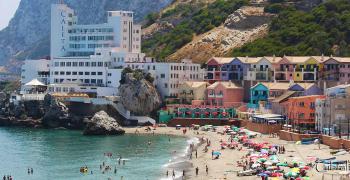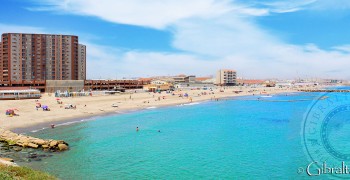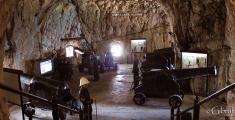Location
3 Willis's Road, Gibraltar
The buildings located here at the exhibition are believed to have been built back during the capture of Gibraltar in 1704, making them the first buildings ever constructed by the British in Gibraltar. The site was initially used as two magazines named after an Officer in the Royal Artillery called Willis, who apparently showed exemplary energy in mounting and serving the guns during the capture of Gibraltar.
Entrance way to the city under siege exhibition showing a good example of the walls and structures that were built.
The two magazines have very thick bombproof walls and were used to store gunpowder, their doorways facing away from Spain (Their enemy at the time). The yard you see in the centre was utilised as a shot yard where cannon balls were piled up in stocks.
The smaller building in the centre court would probably have been used as accommodation for the guards manning the magazines. When the newer and more modern magazine was built further up at Willis’s Battery proper, this older magazine was handed over to the Royal Engineers for their use.
About 50 metres up the road from the exhibition you will find an old Lime Kiln which was used back then to heat up a hundred cannon balls at once till they were red hot (Nicknamed as Roast Potatoes). Once fiery hot, they were carried in barrows full of sand to be used at the batteries located above.
While visiting the City Under Siege Exhibition, one of the most unique and intriguing aspects of the buildings is the numerous graffiti that you will see engraved on the walls. As you could imagine, sieges being generally stalemate situations, were often extremely boring. Many soldiers passed their long hours of duty by carving graffiti in the walls of the buildings. Back then too, falling asleep whilst on duty, was an offence punishable by death, hence keeping yourself awake by drawing on the walls wasn’t a bad idea!
Interesting Fact
Amidst the numerous graffiti on the walls there are a couple in particular that stand out from the rest. The oldest one bares the name of Richard dating back to 1726, the other one featuring a drawing of a galleon alongside the name of ’Ince’ – Maybe it was engraved by the famous Sergeant Major Ince, the architect of the Great Siege Tunnels?
Maintaining law and order in a Garrison Town had to be very strict for both military and civilians. People having to live together, filled with high tension and access to alcohol, meant that in some cases to keep the discipline, punishments inflicted were often quite severe. Flogging with a 'Cat-O-Nine-Tails' whip was one of the most common forms of punishment.
Flogging was the most common form of punishment carried out with a 'Cat-O-Nine-Tails' whip.
Having said that, there are cases which show that even severe flogging was sometimes no deterrent to committing crime, as is shown by a drummer of the Lancashire Regiment who held the record for the most flogged man in the British Army. In his first 14 years of service he received 30,000 lashes, of which 4,000 were administered in his first year of service!
During the Great Siege, General Eliott prevented his soldiers from powdering their hair with flour to conserve stocks. As an example to the rest, he even survived for a week on no more than four ounces of rice a day. To take advantage of the extremely high prices that would be paid for even poor quality food at small quantities, North African ships would do their best to smuggle supplies across enemy lines.
It was said that even a cabbage could cost the equivalent to two and a half days of a soldier’s wages. That being said, can you believe that the head and feet of a sheep was said to sell for more than three weeks of a soldier’s pay? During these harsh times, civilians were said to survive on almost nothing more than seaweed, wild onions and grass!
As a result of extremely poor diet and living so bound up together in unhealthy conditions over long periods of time, it was inevitable that disease would finally take hold. Yellow fever, smallpox, influenza, scurvy and dysentery took the lives of many. Smallpox alone had killed over 500 people within the first year of the Great Siege. Horrible to think that the highest mortality rate was actually amongst the children. From statistics clearly recorded by the military, it shows that diseases were far more dangerous than enemy bombs.
The City Under Siege Exhibition displays various depicted scenes within its walls showing how hard times were for both civilian and military to survive. Many stories have been handed down through the generations of how these first British settlers of Gibraltar had to cope with the often harsh way of life here. Famine, sickness and bombardment from enemies was a continuous way of life for these courageous settlers.


































































